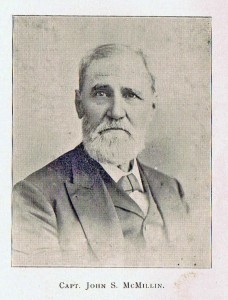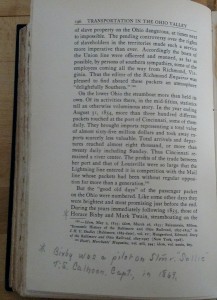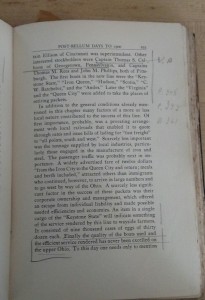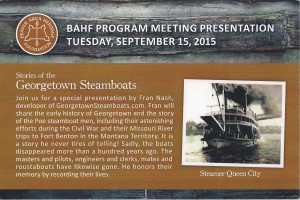 Over the weekend, David McMillin introduced me to his triple great grandfather David Bruce McMillin who was born in Georgetown on 28 Jan 1810. The McMillins owned Lots 52 and 53 on the town square. Lot 7 on the river next to Capt Andrew Parr was listed to Steel McMillin. A daughter, Sarah McMillin, married George Nash who owned property and a sawmill along Smith or Nash Run.
Over the weekend, David McMillin introduced me to his triple great grandfather David Bruce McMillin who was born in Georgetown on 28 Jan 1810. The McMillins owned Lots 52 and 53 on the town square. Lot 7 on the river next to Capt Andrew Parr was listed to Steel McMillin. A daughter, Sarah McMillin, married George Nash who owned property and a sawmill along Smith or Nash Run.
 The email exchange that peaked my interest was the statement that John Smith McMillin was a steamboat captain who owned the str Silver Wave. I had read about the str Silver Wave, but had no idea of its connection to Georgetown. Capt John S McMillin also invented the steam capstan. He was awarded a patent, but litigation regarding that patent was ultimately decided by the Supreme Court against Capt McMillin.
The email exchange that peaked my interest was the statement that John Smith McMillin was a steamboat captain who owned the str Silver Wave. I had read about the str Silver Wave, but had no idea of its connection to Georgetown. Capt John S McMillin also invented the steam capstan. He was awarded a patent, but litigation regarding that patent was ultimately decided by the Supreme Court against Capt McMillin.
The str Silver Wave was the first non-gunboat to pass the batteries at Vicksburg. So Georgetown had two captains with their steamers loaded with troops and supplies at Vicksburg. The str Horizon owned by Captains John N McNurdy and Thomas S Calhoon, collided with the str Moderator on its second pass by the batteries. The str Horizon owned was a complete loss with many lives lost.
In the coming days, I will be adding a bio of Capt John S McMillin, researching the capstan patent, and amending the pages to include him and his steamers histories. Till then a bio of Capt McMillin follows. It was included in the history of A history of the Grace Church Parish transcribed or contributed by Joan Skinnell Benincasa.
CAPT. JOHN SMITH MCMILLIN.
John Smith McMillin, son of William and Catherine Smith McMillin, Scotch-Irish Covenanters, who settled in Beaver County at the close of the last century, was born July 23, 1817, in Georgetown, Beaver County, Pa., where he spent his youth and received a common school education. He was the fourth child of a family of thirteen children. When fifteen years old he engaged in keel-boating on the Ohio River; he next became a pilot on a steamboat, and soon, by quickness and attention to business, he became a captain and was master and owner of several fine boats, and ran regularly to Memphis, New Orleans and all points on the Lower Mississippi River. During the Civil War he won for himself high reputation for bravery by fearlessly running the blockade at Vicksburg in his boat, the Silver Wave, and carrying supplies to the army below the city.
He invented and put into successful use the well-known steam capstan, now a necessary part of the equipment of every river steamboat.
In April, 1853, he moved to Pittsburgh and built a home on Grandview avenue, corner of Bigham street, Mount Washington, where he continued to reside until his death.
He was married twice. His first wife was Phebe Ann Fry, daughter of Dr. Thomas Fry, of Rhode Island, who moved with his family to Georgetown. They were married in Georgetown in December, 1846, and Mrs. McMillin died in Pittsburgh July 8, 1866, leaving no children. His second wife, Mary Bindley, eldest daughter of John C. and Elmina Bindley, of Pittsburgh, he married August 7, 1867. She and three children, one daughter and two sons, survive him. He was baptized by Dr. Killikelly, in Grace Church, July 10, 1866, at the funeral of his first wife, beside the remains, and was confirmed by Bishop Kerfoot in St. Peter’s Church, Pittsburgh, April 14, 1867. He was a vestryman of Grace Church nearly thirty years ; was several times senior warden ; six years treasurer of the church, and was frequently deputy of the same church to the Annual Convention of the Diocese of Pittsburgh. He was a liberal contributor to the expense of putting a basement schoolroom under the church in 1865, and also to the fund for finishing and furnishing the church in 1869. He was a contributor to the support of the church from the time he moved to Mount Washington and a communicant of the same for twenty-six years. He died March 11, 1893, in the seventy-sixth year of his age.
The circumstances of his death were peculiar. On Saturday morning, March 11, 1893, he started as usual for his place of business in the city, the Bindley Hardware Company. Near his gate he met Miss Elizabeth Kenah, and they walked on together, the Captain being, as he often was, in a joking, playful mood. They were proceeding along Grandview avenue going toward the Monongahela Incline Plane, and had just crossed Stanwix street, when he threw his left hand up to his head with an exclamation of sudden pain, tottered, and laid hold of the fence at the side of the street, sank down to the ground and in a few moments (before a physician could reach him) was dead.
The funeral service was held at his late residence on Tuesday, March 14, 1893, at 2 P. M., in the presence of a large gathering of his relations and friends, and he was buried the same afternoon in Allegheny Cemetery.
He was a well-known man, of strong character, noted for his simplicity, honesty and sincerity.
The Rev. R. J. Coster, in an address at his funeral, said:
“God’s providences sometimes touch our hearts with peculiar force and stir our feelings to their lowest depths. Their suddenness and their pathetic surroundings point to God’s immediate presence and tell us that they are the work of His Hand. We cannot read the secret counsels of the Almighty; but this we know, His ways are wise and merciful. He doeth all things well. His infinite wisdom precludes mistakes. In faith, therefore, we bow to His Blessed Will, believing that His ordering is best. In times of sudden bereavement, like this, the promises of God’s Holy Word come to give us resignation and comfort. The Church of Christ, the mother of all the believing, comes to us with her sacred ministrations; her lessons and her prayers speak to us in Christ’s name and bid us fear not, faint not.
“These thoughts harmonize well with the occasion that brings us together here today. Our friend and fellow-servant of God, to whom His Master granted more than his three-score years and ten, has been suddenly taken from our midst. So unexpected was the summons that we can hardly yet realize that we shall no more meet him in his home; no more meet him in the church. We have been so long accustomed to see his tall form and his striking features, so long accustomed to see his kindly smile and to hear cordial welcome, that we shall sadly miss him many days. We had learned to look upon him almost as a permanent part of this community. For forty years he had occupied this home and identified himself with the interests of this section of the city. Most or all of those years he has been closely connected with Grace Church. For nearly thirty years he was one of its vestrymen; he was several times senior warden, for many years treasurer, and frequently he represented his parish in the Diocesan Convention All these years he and his family have been members of Grace Church, and often have they come to its aid in times of need. Some of you have known our departed friend longer than I have, but for nearly twenty-five years I have enjoyed his friendship and confidence.
His home was always open to me, and here I always met a kindly greeting and a
The Rev. R. J. Coster, in an address at his funeral, said:
“God’s providences sometimes touch our hearts with peculiar force and stir our feelings to their lowest depths. Their suddenness and their pathetic surroundings point to God’s immediate presence and tell us that they are the work of His Hand. We cannot read the secret counsels of the Almighty; but this we know, His ways are wise and merciful. He doeth all things well. His infinite wisdom precludes mistakes. In faith, therefore, we bow to His Blessed Will, believing that His ordering is best. In times of sudden bereavement, like this, the promises of God’s Holy Word come to give us resignation and comfort. The Church of Christ, the mother of all the believing, comes to us with her sacred ministrations; her lessons and her prayers speak to us in Christ’s name and bid us fear not, faint not.
“These thoughts harmonize well with the occasion that brings us together here today. Our friend and fellow-servant of God, to whom His Master granted more than his three-score years and ten, has been suddenly taken from our midst. So unexpected was the summons that we can hardly yet realize that we shall no more meet him in his home; no more meet him in the church. We have been so long accustomed to see his tall form and his striking features, so long accustomed to see his kindly smile and to hear cordial welcome, that we shall sadly miss him many days. We had learned to look upon him almost as a permanent part of this community. For forty years he had occupied this home and identified himself with the interests of this section of the city. Most or all of those years he has been closely connected with Grace Church. For nearly thirty years he was one of its vestrymen; he was several times senior warden, for many years treasurer, and frequently he represented his parish in the Diocesan Convention All these years he and his family have been members of Grace Church, and often have they come to its aid in times of need. Some of you have known our departed friend longer than I have, but for nearly twenty-five years I have enjoyed his friendship and confidence.
His home was always open to me, and here I always met a kindly greeting and a
cordial welcome. I constantly met him on terms of closest intimacy, and this intimacy only increased my confidence and respect for the man. As one learned to know him well, and to understand his ways and modes of expression, one could not fail to appreciate the sterling traits of his character, his simplicity, his honesty, his sincerity. Like every man of strong character, he had his peculiarities, and these peculiarities caused him sometimes to be misunderstood by those who imperfectly knew him. But to his intimate friends these peculiarities only intensified his personality and made him the man that they love to honor and remember. His sudden departure while still busy with his ordinary duties, the tragic termination of his active life, will tend to prolong his memory and to deepen the keenness of our sense of loss. But let us not sorrow for him as men without hope. He was a believer in Christ. He was a communicant of the Church. He died in the faith; and although he was reserved in the expression of his religious convictions, as most men of a like character are, yet he accepted the great truths of the Gospel and died trusting in his Lord. We can, therefore, lay him to rest believing that God will deal mercifully with him for Christ’s sake and give him the rest and peace that shall be the portion of his faithful people.”
Burials.
July 10. 1866:
PHEBE ANN McMILLIN, aged 50 years, wife of Capt. John S. McMillin, of Grandview avenue and Bigham street. Service at the church, conducted by Dr. Killikelly, the rector, assisted by the Rev. Dr. Page and the Rev. Mr. Snively, of the city. Buried in Allegheny Cemetery. “A devout communicant of Grace Church, a most excellent Christian woman and a valuable member of the church and of society.”
March 14, 1893:
JOHN SMITH McMILLIN, aged 76 years. Service at the late residence of the deceased, Grandview avenue and Bigham street, and interment in Allegheny Cemetery, the Rev. R. J. Coster, his pastor and friend for twenty-five years, officiating. A strong character, noted for his simplicity and integrity. (See obituary.)
Copyright © 2016 Francis W Nash
All Rights Reserved
No part of this website may be reproduced without permission in writing from the author.







